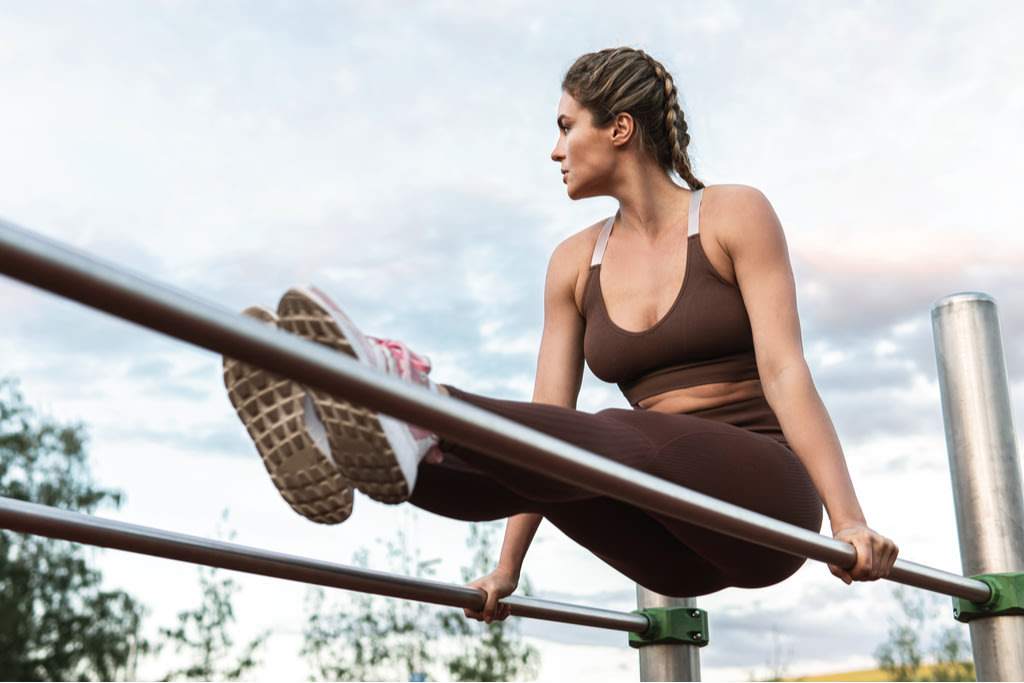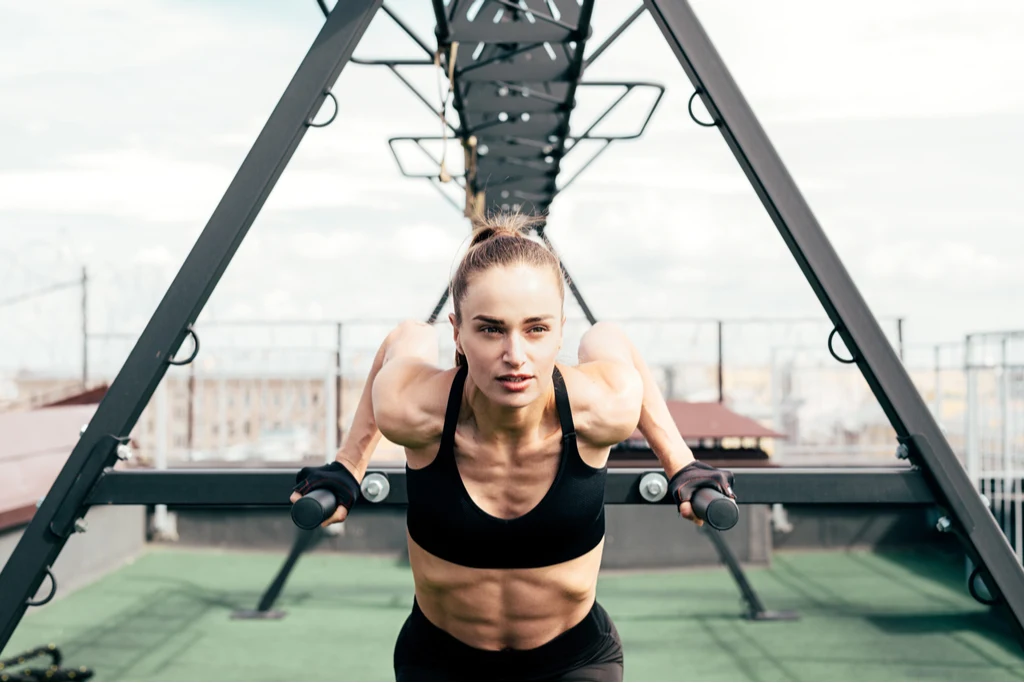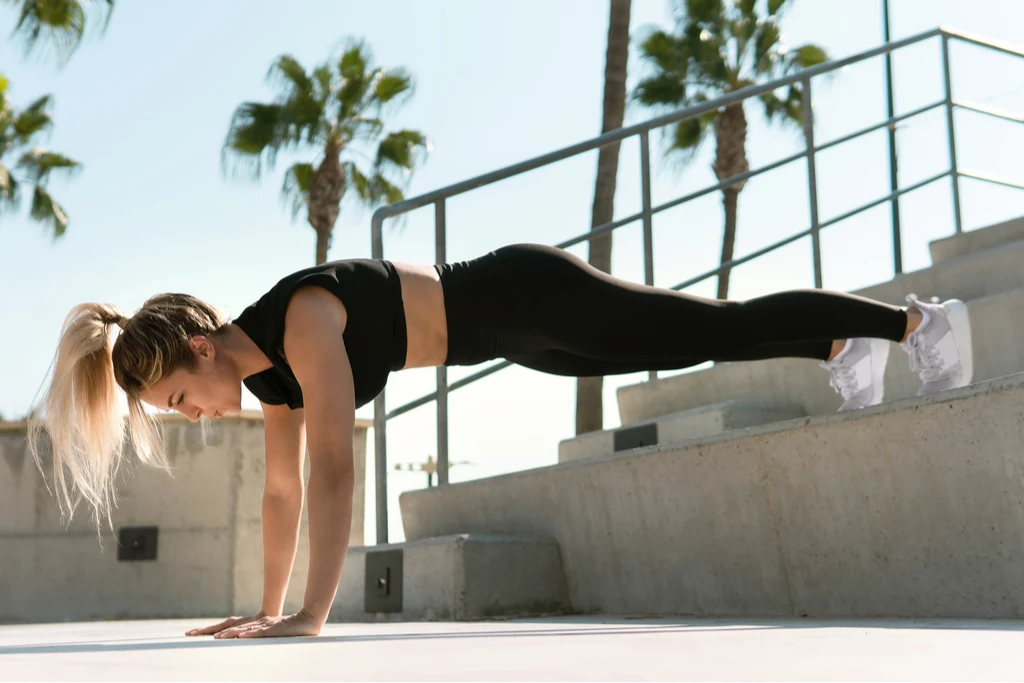Calisthenics For Beginners: What It Is & How To Start
It’s amazing for all fitness levels, jam packed with full-body benefits and can be done anywhere, anytime.

March 6, 2020 - Updated October 29, 2024

Whether you’ve been working out for years or you’re just starting out on your fitness journey, you’ve probably heard of calisthenics before. It’s been around for centuries, is incredibly beneficial for your overall strength and fitness, and chances are, it’s already part of your routine!
What is calisthenics?
Calisthenics is a form of strength training that uses the resistance of your body and gravity to help strengthen your muscles and improve your coordination, endurance and mobility. Almost all common bodyweight exercises are actually calisthenics exercises such as squats, push-ups, lunges and crunches!
Calisthenics exercises range from simple, beginner-friendly movements that don’t require any equipment like squats, to advanced movements that require equipment such as a bar or gymnastics rings such as pull-ups and muscle-ups (the same as a pull-up, except you pull your entire torso above the bar).
Calisthenics exercises are something you can include in your strength training routine, or a training style you can solely focus on. The best part? You can practice calisthenics anywhere — from your at-home workout space to the gym, a hotel room, or even outdoors!
Calisthenics vs weight training
Calisthenics uses your bodyweight as resistance while weight training builds strength using external weights like dumbbells, barbells, medicine balls, kettlebells or gym machines.
They are both amazing ways to build your strength and can complement one another. The best way to structure your schedule will depend on your fitness goals, what equipment and space you have, and of course, what type of exercise you actually enjoy!
Making progress (aka *gains*) with weight training involves using progressive overload to gradually increase the amount of weight you can lift, while making progress with calisthenics involves working towards advanced exercises or variations. Once you’ve mastered push-ups on your toes, you would then challenge yourself with options like spider push-ups, decline push-ups, travelling push-ups or even plyo push-ups!
The benefits of calisthenics
There are so many amazing benefits of calisthenics, some of our favourites include…
You can do it anywhere
One of the many benefits of calisthenics is you can get started without any equipment, which makes it a great form of strength training for beginners, perfect for at-home workouts and a great way to stay active on holiday. Believe it or not, you can see amazing fitness results with a very simple (not to mention affordable) set-up.
According to a 2017 study published in Isokinetics and Exercise Science, calisthenics can help improve posture, strength and body composition without the use of major training equipment.
If you’re looking to try a new training style, mix up your routine or give yourself a fresh challenge, some simple pieces of calisthenics equipment can help level up your training. These include:
Parallettes: two bars on stands that sit parallel to one another
Pull-up bar: perfect for exercises such as hanging knee raises, pull-ups and muscle-ups
Resistance band: the variable resistance in a thick elastic band can be used to make exercises easier or more challenging
It’s great for beginners
Many calisthenics exercises are easy enough for beginners to master and have a low risk of injury, such as bodyweight squats and push-ups. If you’re new to fitness, calisthenics can help you master your form and build confidence before progressing to more advanced variations or adding weights.
It can be low impact
While you can certainly dial up the intensity of a calisthenics session by adding explosive jumping movements to your movements, calisthenics workouts don’t need to be tough on your joints. Not a fan of plyometric exercises? Not a problem. Stick to your isometric variations such as regular squats over jumping squats to keep things low impact.

It works your whole body
Calisthenics training can easily be a full-body workout if you incorporate a range of upper and lower-body exercises into your session. You’ll need to engage your core throughout many calisthenics movements to maintain your balance and technique.
It helps you move better in everyday life
The 2017 study we previously mentioned also found that after eight weeks of training, participants had improved their posture, strength and body composition.
Another 2015 study published in the Journal of Exercise Physiology Online investigated the effects of calisthenic exercises in Physical Education classes in school children. It found incorporating bodyweight calisthenics exercises (such as push-ups, squats and lunges) increased their strength, compared to recreational sports activities alone, ultimately recommending calisthenics should be part of a well-rounded fitness program for children! It’s a great way to support athletic performance, overall health, movement and quality of life at every stage of life.
It makes you stronger
Calisthenics can help you build full-body strength and increase your muscle mass over time, and as your strength improves, you can continue to make the exercises more challenging!
Alongside the many push-up variations, you can increase the difficulty of a squat by adding pulses or trying single-leg pistol squats. You can also slow down or hold exercises to dial up your time under tension (this is where those muscle shakes start!), or make them faster to increase explosive muscular power and athleticism.
It’s fun!
Whether you’re learning squat basics, are trying to master movements on a pull-up bar, or you’re looking to improve your balance with single-leg or arm exercises, there are so many ways to keep your training fun and exciting as you build strength and flexibility with calisthenics.

Some common misconceptions
Contrary to popular belief, calisthenics is suitable for all experience levels! While many people immediately picture gymnastic-style movements on bars and rings, that’s definitely the advanced level. Let’s debunk some of those common myths!
You can’t build muscle
As so many of the strong women in the Sweat Community know, bodyweight exercises can definitely help you build strength and muscle! Just like any strength training routine, it takes consistent effort to see results.
Harvard Health has highlighted that there is a body of research to support the idea that bodyweight exercise helps build strength and endurance, independent of an external load. A small 2016 study also confirmed contracting muscle through a full range of motion with no external load increases muscle size, similar to high-load training!
Another small 2017 study published in the Journal of Exercise & Fitness investigated the effect of push-up training compared to low-load bench press, with participants in the two groups performing the movements twice a week over eight weeks. The results found both exercises induced significant increases in muscle thickness, with no significant differences between the two.
So if you’re looking to build strength and muscle, regardless of your fitness level or equipment, calisthenics can make a great training option.
It’s not for women
As explained in an article from Princeton University, the average man typically has greater upper-body strength than the average woman, largely due to differences in body composition. This has led to the belief that calisthenics, which includes exercises like pull-ups or advanced push-up variations that demand significant upper-body strength, are better suited to men. Is this a myth? Absolutely!
A 2016 study published online by the National Institutes of Health tracked upper-body strength gains between men and women after 10 weeks of resistance training, finding no significant differences in strength gains between sexes and concluding that there should be no need to design different resistance training programs for men and women. There’s no reason why women should shy away from calisthenics exercises.

You can’t increase resistance
It’s common to think it’s hard to increase the difficulty when training with bodyweight alone. This isn’t true! Here are a few ways you can progress your calisthenics training and increase resistance without adding external weights:
Incorporate resistance band exercises
Increase your reps or speed
Adjust the pace of each rep to spend more time under tension, for example by taking 3-5 seconds to lower into a squat and one second to power up!
Add small pulses to your movements, such as squat pulses, pulses at the bottom of a push-up, or pulsing lunges
Try advanced exercise variations (for example, progressing from banded or assisted pull-ups to unassisted pull-ups, chest-to-bar pull-ups, and eventually muscle-ups)
Do plyometric (jumping) versions of exercises such as jump squats to increase your heart rate and build explosive power
Best calisthenics exercises
This will all come down to your level of strength, experience and preferences. If you’re a beginner, it’s best to start with the basics, but if you’ve been working out for some time and are looking for more of a challenge, you could dive straight into the more advanced calisthenics exercises.
Calisthenics exercises for beginners
Squats
Bodyweight squats are a simple and effective exercise on their own, or you can place a resistance band around your thighs to increase the resistance.
Lunges
Bodyweight lunges can either be done on the spot by stepping forward or backwards, or you can try walking lunges where instead of bringing your feet back together, you take another lunging step forwards. You can even increase the intensity and do these as jump lunges for more of a challenge.
Bent and straight leg raises
Leg raises can be performed lying on the ground to improve stability in your lower back. As your strength improves you can try using a bench or progress to hanging leg raises holding onto a bar or rings.
Planks
Planks are a simple yet challenging exercise that work a whole lot of muscles. This movement is great for stability, balance and core strength. After a more difficult variation? Here are plenty of plank variations to upgrade your next workout.
30 SECS
Push-ups
Start by doing push-ups on your knees, or standing with your hands up against a wall, and eventually progress to push-ups on your toes. This exercise is great for building upper-body and core strength.
Advanced calisthenics exercises
Once you become more confident, you can increase your training complexity and intensity with these exercises:
Burpees
Burpees are a great high-intensity exercise that work multiple muscle groups at the same time, making them a great movement for building full-body strength and muscular endurance.
Pull-ups and chin-ups
Pull-ups are challenging, so if you’re a beginner you can practice your technique by using a resistance band to support your bodyweight — simply wrap the band around the pull-up bar and place your feet into the loop before you get started.
Chin-ups are similar to pull-ups but are performed with an underhand grip with your palms facing towards your body. This movement will engage more of your biceps and the front of the shoulders compared to pull-ups. If you can’t do a chin-up, try using a resistance band to support your weight as you build your strength, or use an assisted chin-up machine at the gym.
Handstands
These are a great way to build strong and stable shoulders. Start by doing a handstand hold with your feet resting on top of a box, or by leaning your legs up against a wall. The progression? Handstand push-ups!
L-sits
L-sits can be done to build strength in your core and upper body, either on the floor or holding onto two bars.
Getting started with calisthenics
Anyone can try calisthenics — you don’t need gym equipment, a personal trainer, or any prior training background. The key to success is simply getting started.
Whether you’re working out at home, in the gym, or a mix of both, calisthenics can easily be incorporated into your routine! Ready to try bodyweight training at home? Kelsey Wells’ PWR Zero program is bodyweight strength training, better than ever.

A more empowered you starts with Sweat, and our editorial team is here to bring you the latest fitness tips, trainer recommendations, wellbeing news, nutritional advice, nourishing recipes and free workouts.
* Disclaimer: This blog post is not intended to replace the advice of a medical professional. The above information should not be used to diagnose, treat, or prevent any disease or medical condition. Please consult your doctor before making any changes to your diet, sleep methods, daily activity, or fitness routine. Sweat assumes no responsibility for any personal injury or damage sustained by any recommendations, opinions, or advice given in this article.
Fitness